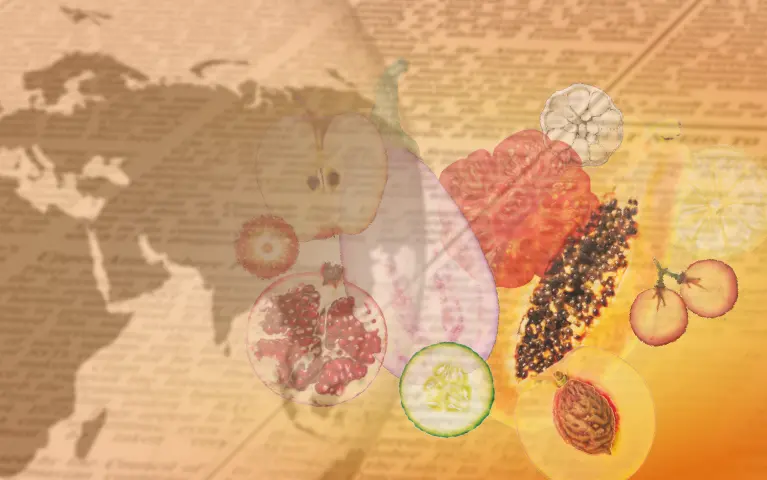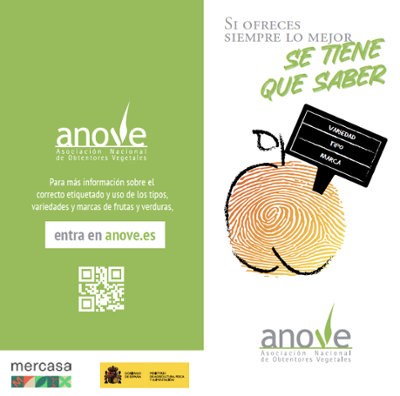

The importance of labelling and branding in fruit and vegetables
Discover why accurately identifying the type, variety and brand of fruit and vegetables is key to protecting innovation and offering transparency to consumers.
Much more than just a pretty box: the brand is also part of the product.
In the world of fruit and vegetables, what we see at first glance—colour, shape, packaging—is only part of the story. Behind each product there is much more: innovation, plant breeding, commercial strategies and, above all, names that matter. Because fruit and vegetables are not just about their taste or appearance: they are also about their variety and, sometimes, their brand.
To shed light on this issue, the National Association of Plant Breeders (ANOVE) has launched an information campaign with a clear objective: to explain why it is so important to label fruit and vegetables correctly and to use registered trademarks correctly at the point of sale.
This educational campaign, aimed at wholesalers, retailers and consumers, seeks to resolve doubts, avoid mistakes and highlight the work of those who innovate from the field to the shelf.
Why is this ANOVE campaign important?
In everyday market life, it is not uncommon to see confusion between brand names, varieties and types of fruit and vegetables. Sometimes, due to the reuse of boxes or ignorance, a product ends up being sold under a brand name that does not correspond to it, or a variety is labelled as if it were another better-known one.
Although most of the time there is no malicious intent, these practices have consequences: from possible legal infringements to loss of brand value or misinformation for consumers.
ANOVE, which brings together companies and research centres that develop new plant varieties, has identified this need and sought to bring order, clarify concepts and defend the value of innovation.
Frequent confusion between brands and varieties
There are many examples. One of the best known is the black tomato sold as ‘Kumato’, even though it is not. Kumato® is a registered trademark that can only be used for a specific variety and marketed under certain conditions. However, its fame has led many retailers to use that name as if it were a type of tomato.
It is also common to see reused packaging from well-known brands used to contain fruit from other sources. Although it may seem harmless, the law is clear: if there is a risk of confusion with a registered trademark, an infringement may be committed, even if that is not the intention.
Other common cases include errors in labelling the variety due to carelessness or failure to update, use of logos similar to registered trademarks, or partial removal of labels without the owner's authorisation.
What is the difference between type, variety and brand?
Type: the general category of the product
The type is a general category, for example, ‘cherry tomato’ or ‘golden apple’, which helps consumers to orient themselves, but has no legal protection.
Variety: the fruit of plant innovation
Variety is the result of the work of breeders, i.e. a specific genetic combination with specific characteristics (resistance, flavour, productivity, etc.), which can be protected by industrial property rights.
Brand: the distinctive sign that builds trust
A trademark is a distinctive commercial symbol (name, logo, colour, design) that identifies a product on the market and is protected by trademark law (*).
Confusing these three concepts can lead to anything from simple mistakes to cases of infringement that damage a product's reputation or may inadvertently confuse the buyer.
Legal consequences of trademark misuse
What the Trademark Law in Spain says
The Trademark Law in Spain protects the exclusive use of registered trademarks. Articles 34.2 and 34.6 state that:
A registered trademark or similar sign cannot be used for products of the same type if there is a risk of confusion.
A trademark's packaging or materials cannot be reused without the owner's consent.
Owners may prevent their trademark from being removed or modified without permission.
Most common cases of infringement
These infringements are not always intentional, but they can have legal consequences and damage the reputation of the product and the company. Respecting trademarks protects innovation and ensures transparency for consumers.
A constructive approach to improving the sector
ANOVE is committed to a constructive and approachable approach. The aim is not to point out mistakes, but to accompany the sector towards a clearer, more conscious and professional use of labelling and branding, promoting good practices that benefit all links in the chain.
Best practices for wholesalers and retail outlets
The campaign has been designed with materials and resources tailored to the different players in the sector, especially wholesalers, who are key players between the producer and the point of sale.
They are encouraged to reinforce the correct identification of varieties and brands, which improves traceability and commercial information and adds value to the channel.
The role of the informed consumer
It also targets consumers, helping them understand that there are different varieties and brands, and that behind each product there is innovation, hard work and quality that deserves to be recognised.
More transparency, more value for everyone
This transparency in labelling helps to build trust, improves the shopping experience and reinforces the prestige of the fruit and vegetable sector.
Conclusion: know what you are selling, respect what you are buying
In an environment such as Fruit Attraction, where the most important professionals in the fruit and vegetable sector come together, this message resonates strongly: taking care of product labelling is not a detail, it is a responsibility.
Because when these rights are respected, innovation is protected, value is added to the brand and consumers are guaranteed to know exactly what they are buying. And in a competitive market, where differentiation is key, this can make the difference between being just another brand... or being the brand that customers come back to.
This ANOVE campaign sends a clear message: the labelling of fruit and vegetables matters. Not only to comply with the law, but because behind every brand and every variety there are years of work, investment and continuous improvement.
And if we want a modern, professional sector with a future, that work must be recognised, respected and, of course, labelled as it deserves.
(*) Law 17/2001, of 7 December, on Trademarks






